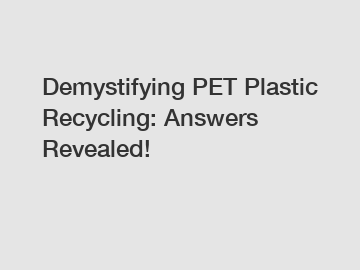Demystifying PET Plastic Recycling: Answers Revealed!
Demystifying PET Plastic Recycling: Answers Revealed!
Have you ever wondered what happens to the plastic bottle you toss into the recycling bin? PET, or polyethylene terephthalate, is one of the most commonly used plastics in packaging. Understanding the process of recycling PET can shed light on the impact our actions have on the environment. So let's dive into the fascinating world of PET plastic recycling and uncover some answers!
1. What is PET plastic and why is it so popular?

PET is a lightweight, durable, and versatile plastic that is used to make a wide variety of products, with packaging being its most common application. From water bottles to food containers, PET has gained popularity due to its excellent clarity, resistance to impact and water, and its ability to be easily shaped into different forms.
2. How is PET plastic recycled?
The first step in PET recycling is collection and sorting. Once the plastic bottles are collected, they are sorted based on their resin type to separate PET from other plastics. Sorting is crucial to ensure a high-quality recycling process.
3. The cleaning and shredding process.
After sorting, the PET bottles go through a rigorous cleaning process. The bottles are thoroughly washed to remove any remaining contents, labels, or other contaminants. Once cleaned, they are shredded into small pieces, known as flakes. These flakes are then separated further by color, as different colored plastics cannot be mixed during the recycling process.
4. The magic of melting and decontamination.
The shredded PET flakes are now ready for the most essential step – melting. The flakes are melted down and transformed into a thick, molten liquid. During this process, any remaining impurities or contaminants are removed through a decontamination process. This ensures that the recycled PET is safe for use in food-grade packaging.
5. Creating new products.
Once the molten PET is free from impurities, it is transformed into small pellets or chips. These pellets can be used to create a wide range of products, such as new bottles, textiles, carpets, and even automotive parts. The recycled PET can be blended with virgin PET or other materials to achieve specific properties required for different applications.
6. The importance of recycling PET.
Recycling PET is crucial for several reasons. Firstly, it reduces the amount of plastic waste that ends up in landfills, reducing environmental pollution. Additionally, recycling PET helps conserve natural resources as it reduces the need for new plastic production. It also saves a significant amount of energy compared to producing new plastic from raw materials.
7. Challenges in PET recycling.
While PET recycling is a beneficial process, it does come with certain challenges. One major obstacle is the collection and sorting of PET bottles. Efficient collection systems and proper education and awareness are essential to ensuring that PET bottles are disposed of correctly. Moreover, maintaining a consistent supply of high-quality recycled PET is essential for its successful integration into the manufacturing industry.
In conclusion, demystifying the process of PET plastic recycling provides valuable insights into the environmental impact of our consumer choices. Understanding how PET is collected, sorted, cleaned, and transformed into new products highlights the importance of recycling and the role it plays in reducing plastic waste and conserving resources. By actively participating in PET recycling and choosing products made from recycled PET, we can contribute to a more sustainable future. So, the next time you hold a PET bottle, remember that it has the potential to be reborn, repurposed, and recycled.
Want more information on rPET pellets, rPET pellets, rPET pellets? Feel free to contact us.


